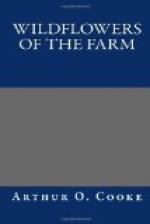Among the bushes of the coppice itself we will notice the flowers which first catch our eye—the pretty blossoms of the Wood Anemone. The whole coppice is starred with the beautiful white flowers. We pick one and see that it has six—six what? “Six petals,” you say. No, these are not petals, for the Anemone has none. They are sepals. The sepals of a plant generally enclose the blossom before it is opened, and they are usually green. In the Anemone the petals are absent; the sepals take their place and are white instead of green. Their under side is often not pure white, but is streaked with pale pink.
Several blossoms which we pick have six of these sepals. That is the usual number, but sometimes there are only five, and sometimes more than six.
The blossoms of the Anemone grow on longer and stronger stalks than those of the Primrose, and on each stalk are three leaves. These leaves grow round the stalk in a ring. Each leaf is “tri-partite”—in three parts or divisions; the edges of these divided leaves are deeply serrated. Besides the three leaves on each flower-stalk similar leaves grow from underground stems which creep along not far below the surface of the soil. Such creeping underground stems are usually called “rhizomes.”
At the further side of the coppice, where a hedge separates it from the little meadow called Home Close, are Sweet Violets. We catch their fragrant scent before we see them, for the tiny flowers are half hidden among broad green leaves. Each blossom has five petals of a dark purple colour; there are white Sweet Violets too, but none are growing in our little wood to-day.
At the base of the blossom—the part where it joins the stem—one of the petals has a little spur which points back towards the stem. The blossom is therefore said to be spurred; we may presently see other plants with spurred flowers.
There is another violet which grows wild in England—the Dog Violet. It is larger than our Sweet Violets here, but it has no scent.
[Illustration: Anemone.]
While we have been examining the flowers on the ground, the nut bushes above our heads are waiting to remind us of what we said just now—that trees also have flowers. The flowers of the nut bush or hazel are easily seen, for they appear before the leaves are open. What we see to-day are often called catkins, but the name which country children give them is lambs’-tails. It is a very good name, too, for they are more like the tail of some tiny lamb than anything else.
These catkins are yellowish-white in colour, and soft and almost woolly to the touch. They hang in clusters from the hazel twigs, and in the strong March wind which blows to-day, they shake and flutter like the tails of lambs at play. Some of them leave a dusty powder on our fingers when we handle them; that is the pollen of the flower.
It is not where these yellow “catkins” are dancing on the twigs to-day that the hazel nuts will appear in autumn. The nuts will grow on twigs where there are very small red flowers—something like tiny paint-brushes. These are the female flowers; they will be fertilized by the yellow pollen of the catkins, and will produce the nuts.




